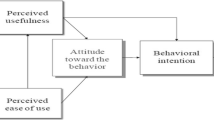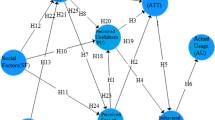Abstract
The incorporation of information and communications technology (ICT) in teaching and learning processes has created new challenges for administrative and academic processes in educational institutions. This paper proposes an E-Learning Tools Acceptance Model (eLTAM) with the purpose of examining the level of acceptance and critical factors of virtual learning tools among university students in developing countries. The methodology involved the application of a self-administered questionnaire to 1032 undergraduate students from three different Higher Education Institutions in Colombia. A confirmatory factor analysis was developed to determine the relation between the set of observed variables and latent variables or factors, defined under the E-Learning Tools Acceptance Model (eLTAM). Results confirm a strong relation between the Perceived Usefulness factor and the variables of Instructor Preparation and Autonomy in Learning, as well as between the Ease of Use factor and the Perceived Self-Efficacy Perception variable. It is concluded the instructor preparation, learning autonomy and perception of self-efficacy are the main factors affecting the adoption of e-learning tools for university students in the studied population.


Similar content being viewed by others
Explore related subjects
Discover the latest articles, news and stories from top researchers in related subjects.References
Abascal, E., & Esteban, I. (2005). Análisis de encuestas. Retrieved from. https://books.google.es/books?hl=es&lr=&id=qFczOOiwRSgC&oi=fnd&pg=PA9&dq=Abascal,+E.,+%26+Esteban,+I.+G.+(2005).+Análisis+de+encuestas.+ESIC+Editorial.&ots=eA0DLaP8Ra&sig=xIpblJGODuwjIl2meNoBw7LADYo. Accessed Dec 2017.
Abbad, M. M., Morris, D., & de Nahlik, C. (2009). Looking under the bonnet: Factors affecting student adoption of E-learning systems in Jordan. International Review of Research in Open and Distance Learning, 10(2), 1–25.
Ahmed, T. (2013). Toward successful E-learning implementation in developing countries: A proposed model for predicting and enhancing higher education instructors participation. International Journal of Academic Research in, 3(1). http://search.proquest.com/openview/8580e88ce8fdcec41224d8e495c5d658/1?pq-origsite=gscholar (Accessed: 21 November 2016).
Al-azawei, A., Parslow, P., & Lundqvist, K. (2017). Investigating the effect of learning styles in a blended e-learning system : An extension of the technology acceptance model (TAM). Australasian Journal of Educational Technology, 33(2), 1–23. https://doi.org/10.14742/ajet.2758.
Anderson, J., & Gerbing, D. (1988). Structural equation modeling in practice: A review and recommended two-step approach. Psychological Bulletin. Retrieved from. http://psycnet.apa.org/psycinfo/1989-14190-001. Accessed Jan 2018.
Bagozzi, R. P., & Yi, Y. (1988). On the evaluation of structural equation models. Journal of the Academy of Marketing Science, 16(1), 74–94.
Batista-Foguet, J., Coenders, G., & Alonso, J. (2004). Análisis factorial confirmatorio. Su utilidad en la validación de cuestionarios relacionados con la salud. Medicina Clínica. Retrievedfrom. https://www.researchgate.net/profile/Germa_Coenders/publication/246614042_Anlisis_factorial_confirmatorio._Su_utilidad_en_validacin_de_cuestionarios_relacionados_con_la_salud/links/5563e87408ae86c06b695b5a.pdf. Accessed Nov 2017.
Bermúdez-Hernández, J., Chalela, S., Arias, J., & Valencia-Arias, A. (2016). Research trends in the study of ICT based learning communities: A Bibliometric analysis. EURASIA Journal of Mathematics, Science and Technology Education, 13(5), 1539–1562. https://doi.org/10.12973/eurasia.2017.00684a.
Bhuasiri, W., Xaymoungkhoun, O., Zo, H., Rho, J. J., & Ciganek, A. P. (2012). Critical success factors for e-learning in developing countries: A comparative analysis between ICT experts and faculty. Computers & Education, 58(2), 843–855.
Boateng, R., Mbrokoh, A. S., Boateng, L., Senyo, P. K., & Ansong, E. (2016). Determinants of e-learning adoption among students of developing countries. International Journal of Information and Learning Technology, 33(4), 248–262. https://doi.org/10.1108/IJILT-02-2016-0008.
Chalela Naffah, S., Valencia-Arias, A., Bermúdez-Hernández, J., & Ortega Rojas, C. M. (2016). Percepciones estudiantiles acerca del uso de nuevas tecnologías en instituciones de Educación Superior en Medellín. Revista Lasallista de investigación, 13(2), 151–162. https://doi.org/10.22507/rli.v13n2a14.
Cheng, Y. M., Lou, S.-J., Kuo, S. H., & Shih, R. C. (2013). Investigating elementary school students technology acceptance by applying digital game-based learning to environmental education. Australasian Journal of Educational Technology, 29(1). https://doi.org/10.14742/ajet.65.
Clay, M., Rowland, S., & Packard, A. (2008). Improving undergraduate online retention through gated advisement and redundant communication. Journal of College Student. Retrieved from http://csr.sagepub.com/content/10/1/93.short. Accessed Nov 2017.
Davis, F. (1989). Perceived usefulness, perceived ease of use, and user acceptance of information technology. MIS Quarterly. Retrieved from. http://www.jstor.org/stable/249008
Dede, C. (1996). Emerging technologies and distributed learning. The American Journal of Distance Education, 10(2), 4–36. https://doi.org/10.1080/08923649609526919.
Díez Echavarría, L. F., Valencia-Arias, A., & Bermúdez-Hernández, J. (2017). Agent-based model for the analysis of technological acceptance of Mobile learning. IEEE Latin America Transactions, 15(6), 1121–1127.
Dominici, G., & Palumbo, F. (2013). How to build an e-learning product: Factors for student/customer satisfaction. Business Horizons, 56(1), 87–96. https://doi.org/10.1016/j.bushor.2012.09.011.
Englund, C., Olofsson, A. D., & Price, L. (2017). Teaching with technology in higher education: Understanding conceptual change and development in practice. Higher Education Research and Development, 36(1), 73–87. https://doi.org/10.1080/07294360.2016.1171300.
Frías-Navarro, D. (2013). Alfa de Cronbach y consistencia interna de los ítems de un instrumento de medida.
Gaviria, D., Arango, J., & Valencia-Arias, A. (2015). Reflections about the use of information and communication Technologies in Accounting Education. Procedia - Social and Behavioral Sciences. Elsevier B.V., 176, 992–997. https://doi.org/10.1016/j.sbspro.2015.01.569.
George, D., & Mallery, P. (2003). SPSS for windows step by step: A simple guide and reference. 11.0 update (4th ed.). Boston: Allyn & Bacon.
Gulati, S. (2008). Technology-enhanced learning in developing nations: A review. International Review of Research in Open and Distance Learning, 9(1).
Hair, J. F., Anderson, R. E., Tatham, R. L., & Black, W. C. (2001). Análisis Multivariante (5ta ed.). Madrid: Prentice Hall Iberia.
Huang, J. H., Lin, Y. R., & Chuang, S. T. (2007). Elucidating user behavior of mobile learning: A perspective of the extended technology acceptance model. The Electronic Library, 25(5), 585–598.
Kaplan, D., Harik, P. & Hotchkiss, L. (2000). Cross- sectional estimation of dynamic structural equa- tion models in disequilibrium. In: R. Cudeck, S. du Toit & D. Sörbom (Eds.), Structural equation modeling: Present and future-a Festschrift in honor of Karl Jöreskog (pp. 315–340). Lincolnwood, IL: Scientific Software International.
Kundi, G., & Nawaz, A. (2014). From e-learning 1.0 to e-learning 2.0: Threats & amp; opportunities for higher education institutions in the developing countries. European Journal of Sustainable Development, 3(1), 145–160. https://doi.org/10.14207/ejsd.2014.v3n1p145.
Lan, Y. F., & Sie, Y. S. (2010). Using RSS to support mobile learning based on media richness theory. Computers & Education, 55(2), 723–732. https://doi.org/10.1016/j.compedu.2010.03.005.
Lee, J., Hong, N. L., & Ling, N. L. (2001). An analysis of students preparation for the virtual learning environment. The Internet and Higher Education, 4(3), 231–242. https://doi.org/10.1016/S1096-7516(01)00063-X.
Lee, B. C., Yoon, J. O., & Lee, I. (2009). Learners’ acceptance of e-learning in South Korea: Theories and results. Computers & Education, 53(4), 1320–1329. https://doi.org/10.1016/j.compedu.2009.06.014.
Lennon, J., & Maurer, H. (2003). Why it is difficult to introduce e-learning into schools and some new solutions. J. UCS. Retrieved from. http://www.jucs.org/jucs_9_10/why_it_is_difficult/Lennon_J.pdf. Accessed Dec 2017.
Lévy, J. P., Martín, M. T., & Román, M. V. (2006). Optimización según estructuras de covarianzas. Modelización con estructuras de covarianzas en ciencias sociales. Ed. Netbiblo, 21–22.
Liaw, S. S. (2008). Investigating students’ perceived satisfaction, behavioral intention, and effectiveness of e-learning: A case study of the blackboard system. Computers & Education, 51(2), 864–873. https://doi.org/10.1016/j.compedu.2007.09.005.
Martínez-García, J., & Martínez-Caro, L. (2009). La validez discriminante como criterio de evaluación de escalas:¿ teoría o estadística? Universitas Psychologica. Retrieved from. http://www.scielo.org.co/scielo.php?script=sci_abstract&pid=S1657-92672009000100002. Accessed Feb 2017.
Meneses, J., Fàbregues, S., Rodríguez-gómez, D., & Ion, G. (2012). Internet in teachers professional practice outside the classroom: Examining supportive and management uses in primary and secondary schools. Computers & Education. Elsevier Ltd, 59(3), 915–924. https://doi.org/10.1016/j.compedu.2012.04.011.
Miller, M., Lu, M., & Thammetar, T. (2004). The residual impact of information technology exportation on Thai higher education. Educational Technology Research and. Retrieved from. http://www.springerlink.com/index/U807754Q06H73693.pdf. Accessed Nov 2017.
Nawaz, A. (2013). Using e-learning as a tool for education for all in developing states. International Journal of Science and Technology. Retrieved from. http://www.academicjournals.org/journal/IJSTER/article-abstract/2F5A48B5265. Accessed Nov 2017.
Ngai, E. W. T., Poon, J. K. L., & Chan, Y. H. C. (2007). Empirical examination of the adoption of WebCT using TAM. Computers & Education, 48(2), 250–267. https://doi.org/10.1016/j.compedu.2004.11.007.
Nora, A., & Snyder, B. P. (2009). Technology and higher education: The impact of e-learning approaches on student academic achievement, perceptions and persistence. Journal of College Student Retention, 10, 3–19.
Ozdamli, F., & Uzunboylu, H. (2015). M-learning adequacy and perceptions of students and teachers in secondary schools. British Journal of Educational Technology, 46(1), 159–172. https://doi.org/10.1111/bjet.12136.
Park, S. Y. (2009). An analysis of the technology acceptance model in Understanding University students behavioral intention to use e-learning. Educational Technology & Society, 12(3), 150–162.
Petrides, L. A. (2002). Web-based technologies for distributed (or distance) learning: Creating learning-centered educational experiences in the higher education classroom. International Journal, 29(1), 69–77.
Piccoli, G., Ahmad, R., & Ives, B. (2001). Web-based virtual learning environments: A research framework and a preliminary assessment of effectiveness in basic it skills training. MIS Quarterly, 25(4), 401–426. https://doi.org/10.2307/3250989.
Ratna, P., & y Mehra, S. (2015). Exploring the acceptance for e–learning using technology acceptance model among university students in India. International Journal of Process Management and Benchmarking, 5(2), 194–210.
Rivera, P., Sánchez, P., Romo, E., Jarmaillo, A., & Valencia-Arias, A. (2013). Percepciones de aprendizaje por medio universitarios frente al los estudiantes de dispositivos móviles. Revista Educación y Desarrollo Social, 7(2), 152–166.
Selim, H. (2007). Critical success factors for e-learning acceptance: Confirmatory factor models. Computers & Education, 49(2), 396–413. https://doi.org/10.1016/j.compedu.2005.09.004.
Selwyn, N. (2011). Education & Technology: Key issues & debates. London: Continuum.
Sirkemaa, S. (2006). Information technology in developing a meta-learning environment. European Journal of Open, Distance and E-Learning. Retrieved from. http://www.eurodl.org/index.php?p=archives&sp=full&article=237. Accessed Dec 2017.
Summak, M., Samancioglu, M., & Baglibel, M. (2010). Technology integration and assesment in educational settings. Social and Behavioral Sciences, 2(2), 1725–1729.
Tarhini, A., Hone, K., & Liu, X. (2014). The effects of individual differences on e-learning users behaviour in developing countries: A structural equation model. Computers in Human Behavior, 41, 153–163.
Tarhini, A., Hone, K., Liu, X., & Tarhini, T. (2017). Examining the moderating effect of individual-level cultural values on users acceptance of E-learning in developing countries: A structural equation modeling of an extended technology acceptance model. Interactive Learning Environments, 25(3), 306–328. https://doi.org/10.1080/10494820.2015.1122635.
Taylor, P., Marín, S. L. T., García, F. B., & Vázquez, S. G. (2008). A technological acceptance of e-learning tools used in practical and laboratory teaching, according to the European higher education area. Behaviour & Information Technology, 27(6), 37–41. https://doi.org/10.1080/01449290600958965. Accessed Dec 2017.
Teo, T., Fan, X., & Du, J. (2015). Technology acceptance among pre-service teachers: Does gender matter? Australasian Journal of Educational Technology, 31(3), 235–251.
Van Raaij, E. M., & Schepers, J. J. L. (2008). The acceptance and use of a virtual learning environment in China. Computers & Education, 50(3), 838–852. https://doi.org/10.1016/j.compedu.2006.09.001. Accessed Dec 2017.
Viberg, O., & Grönlund, Å. (2013). Cross-cultural analysis of users’ attitudes toward the use of mobile devices in second and foreign language learning in higher education: A case from Sweden and China. Computers & Education, 69, 169–180. https://doi.org/10.1016/j.compedu.2013.07.014.
Wong, G. K. W. (2015). Understanding technology acceptance in pre-service teachers of primary mathematics in Hong Kong. Australasian Journal of Educational Technology, 31(6), 713–735.
Wu, J. H., Tennyson, R. D., & Hsia, T. L. (2010). A study of student satisfaction in a blended e-learning system environment. Computers & Education, 55(1), 155–164.
Author information
Authors and Affiliations
Contributions
The three authors provided and wrote the Conceptualization. AVA and JBH participated in compiling the questionnaires, gathered and transcribed. The three authors participed in the analysed the questionnaire data and in the discussion. The three authors read and approved the final manuscript.
Corresponding author
Ethics declarations
Competing interests
The authors declare that they have no competing interests.
Availability of data and materials
Original data are not publically available due to ethics restrictions on identifying participants.
Additional information
Publisher’s Note
Springer Nature remains neutral with regard to jurisdictional claims in published maps and institutional affiliations.
Rights and permissions
About this article
Cite this article
Valencia-Arias, A., Chalela-Naffah, S. & Bermúdez-Hernández, J. A proposed model of e-learning tools acceptance among university students in developing countries. Educ Inf Technol 24, 1057–1071 (2019). https://doi.org/10.1007/s10639-018-9815-2
Received:
Accepted:
Published:
Issue Date:
DOI: https://doi.org/10.1007/s10639-018-9815-2




